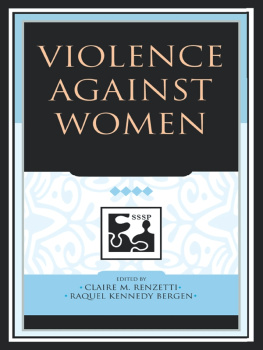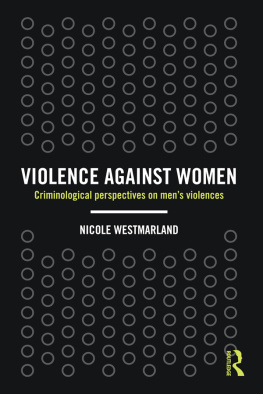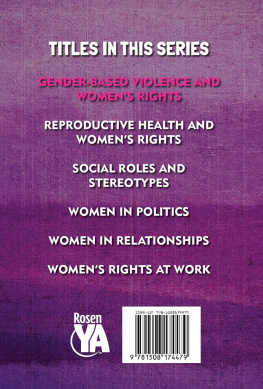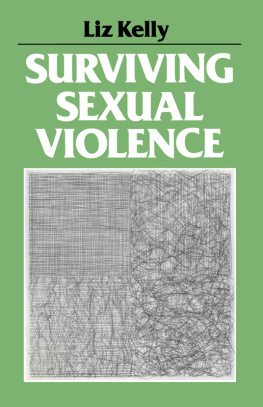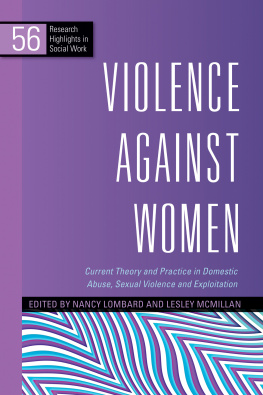Published by
STATE UNIVERSITY OF NEW YORK PRESS, ALBANY
2012 State University of New York
All rights reserved
Printed in the United States of America
No part of this book may be used or reproduced in any manner whatsoever without written permission. No part of this book may be stored in a retrieval system or transmitted in any form or by any means including electronic, electrostatic, magnetic tape, mechanical, photocopying, recording, or otherwise without the prior permission in writing of the publisher.
For information, contact
State University of New York Press, Albany, NY
www.sunypress.edu
Production and book design, Laurie D. Searl
Marketing, Fran Keneston
Library of Congress Cataloging-in-Publication Data
Price, Joshua M.
Structural violence : hidden brutality in the lives of women / Joshua M. Price.
p. cm.
Includes bibliographical references and index.
ISBN 978-1-4384-4344-7 (pbk. : alk. paper) ISBN 978-1-4384-4343-0
(hardcover : alk. paper) 1. WomenViolence againstUnited States. 2. WomenViolence againstUnited StatesPrevention. I. Title.
HV6250.4.W65P724 2012
362.83dc23
2011041967
10 9 8 7 6 5 4 3 2 1
Acknowledgments
In the course of research, I have been inspired over and over again by the courage, intelligence, and fortitude of many women, especially survivors of violence. I have learned enormously from their thinking and analyses. This book is built on the insights and experiences of activists and advocates in the struggle to stop violence against women. Of course, I take full responsibility for whatever I have gotten wrong.
The political concepts at the root of this book took form while I was a member of a center for popular education, the Escuela Popular Nortea. I want to thank my compaeras/os, in particular, Mara Lugones, Laura Dumond Kerr, and Julia Mara Schiavone Camacho. Our collaborative work, critical companionship, and conversations over the course of more than a decade were fundamental for me to think as I do and transform as (I hope) I have. The contribution and support of Mara Lugones, in particular, were inestimable at every stage of the process of this book. She helped shape my understanding of violence against women. She also read and commented generously on numerous versions of this text. I am deeply grateful to her. In EPN, Rafael Mutis, Rick Santos, Hector Mauricio Graciano, and Geoff Bryce offered a context in which to take in and think through critiques of violent masculinity by feminists of color. Over the course of years, in conjunction with the women of color in our collective, we developed techniques to work with men against violence against women of color. Other members of the collective who influenced my thinking include Aurelia Flores, Dalida Mara Benfield, Cricket Keating, Suzanne LaGrande, Mildred Beltr, Rob Gonzalez, Isabel Gonzalez, and Sarah Lucia Hoagland. Sarah's work has also changed how I think about resistance and agency under oppression, as well as my understanding of lesbian identity. Sarah also made extensive, and very helpful, comments on an earlier draft.
Many other activists have shared their time, acumen, and hard-won sagacity generously with me. Bertha Hinojosa, Caridad Souza, Veronica Frankel, and Marta Garca each took time to speak with me of the struggle to stop violence against women in its variegated character, especially Latina immigrants, poor women, homeless women, and Latina lesbians. They have also added dimension to my critical take on the shelter movement and on law courts.
I would like to acknowledge my gratitude to Rozann Greco, Mary DeGroat, Kathy Pierre, Candis Henderson, Noelle Paley, Cheryl DeRosa, Felicia Jennings, and Nancy Jennings, who taught me about the intersection of incarceration and structural violence in women's lives. I learned a lot from Noelle and Rozann in particular, from working, writing, and thinking with them while engaged in advocacy for the currently and formerly incarcerated, often in very trying circumstances. In that spirit I would like to mark the countless other women and men, community members, and university students involved in the Broome County Jail Project and in the Southern Tier Social Justice Project.
I have benefitted from terrific colleagues and excellent students at Binghamton University. M. Sue Crowley and my colleague and appa Lubna Chaudhry, on top of years of productive dialogue, both read the manuscript and gave valuable suggestions. Lubna introduced me to the concept of structural violence.Rudiah Primariantari taught with me, and I learned a great deal from her about structural violence and the oppression of women in the global South. The Radical Interdisciplinary Dialogue, and then the Working Group on Methodologies of Resistant Negotiation in Binghamton, provided critical commentary and a receptive space to do interdisciplinary work, as well as a forum in which to rethink the possibilities of anthropology given deep challenges. Members included Kelvin Santiago-Valles, Gladys Jimnez-Muoz, Risa Faussette, Kai Lundgren-Williams, Rudiah Primariantari, Mara Lugones, Julia Glanville, Tabor Fisher, Elizabeth Morrison, Manuel Chvez, Jennifer Lutzenberger, and Chris Cuomo. I thank generations of students, especially those women who shared their stories with me and gave me critical feedback.
A stay at the James Weldon Johnson Institute for Advanced Interdisciplinary Research, of Emory University, under the able, generous, and visionary stewardship of its founder and director, Rudolph Byrd, and its associate director, Calinda Lee, supplied a wonderful and collegial setting in which to finish this manuscript. Professor Byrd passed away as this book goes to press. His guidance, leadership, initiative, not to mention his good spirit, will be missed. We are impoverished by his absence. A generous leave provided by the State University system, with support from Deans Ernest Rose and Ricardo Lauremont gave me time and support to write.
Karen Wenzel taught me about the clandestine networks rural women use to survive violence. I learned more from Karen than from any other student I have ever had. May she rest in peace.
It was at Caitrin Lynch's invitation that I initially attended domestic violence court in Chicago. Michael Silverstein taught me how to study language and interaction, and Elizabeth Povinelli lent support at a critical juncture. Gary Wilder, William Bissell, and Nicholas DeGenova gave early feedback to the writing and helped me navigate those years in Chicago.
Jonah Murdock made a home with me for the important first years of this research, a time that I regard with enormous tenderness and fondness. He also contributed important critical responses on several drafts of this manuscript, especially to my understanding of liberalism and the private/public split. Beth Murray also supplied crucial companionship, as did Zohar, my constant companion from early morning until late at night.


